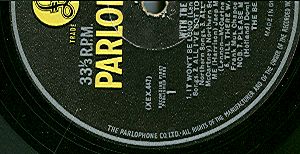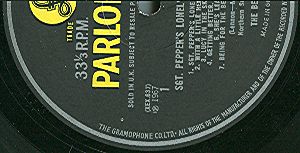
When collecting Beatle LPs, the condition of the vinyl is obviously important however the record's label plays a significant role in determing the overall value of the LP. In fact some labels are so collectible, that the condition of the vinyl is a secondary factor. Below is a quick reference guide for US and UK Beatle label identification. I will also include links to sites that offer expanded reference material for those wishing to pursue additional research (see the bottom of the page).
The Vee Jay (VJ) Labels
In the beginning, the very first US Beatle LP came out on the VeeJay (VJ) label. VJ entitled the album Introducing The Beatles and is one of the most counterfeited LPs in history. There are many ways to tell the real deals from the counterfeits and the links below will take you to sites that go into great detail on how to tell the difference, but in the end one of the best ways to quickly identify an authentic pressing from a fake is the LP label.
The first three labels below are authentic . There are two key characteristics: 1) "The Beatles" is above the spindle hole, and 2) for the VJ colorband labels, the colors are uniform and include the green color in the band (around the 7 o'clock position). Fakes printed "The Beatles" below the spindle hole (see scan #4 below) and the fake colorband versions (not shown) excluded the green color in the band and in some cases the band was not proportionate all the way around the label.
Some clever colorband fakes did place "The Beatles" above the spindle hole but the colorband around the label is of poor quality.
In general, the VJ "oval" label (top left) is more valuable then the bracket version. The bracket version is more collectible than the black & silver label. The labels above are the mono versions. You will see many counterfeits for sale that claim to be "stereo". Stereo copies of Introducing The Beatles are rare. The mono pressings far out number their stereo counterparts. All true stereo copies have the word "stereo" printed on the label. If a seller claims to be selling a stereo copy and the word "stereo" is not printed on the label, it is a fake stereo copy. Other characteristics that determine value are the label fonts, whether the text is left aligned or center aligned, etc.
The Capitol Labels
Subsequent to VJ Beatle LPs were pressed on Capitol records. Below are three versions of the famous Capitol colorband label. The first label represents an original pressing. The second, which is commonly known as the "subsidiary" label was pressed in 1968 and the third is the 1983 re-issue where Capitol took a trip down a memory lane and replicated the original colorband label. There are ways to tell the three apart and I will call them out below. For Capitol LPs, record numbers beginning with "T" or "M" were mono recordings. Those beginning with "ST" or "SM" are stereo pressings.
There were two other labels Capitol pressed during the Beatle period (i.e., when the band was together). Both are often referred to as the "target" labels due to the design of the Capitol logo at the top of the label. The green target label was pressed for one year in 1969. The red target label came after its green counterpart and technically no Beatle LPs in the US were supposed to be pressed on the red label since the Beatle catalog was either now on Apple or being re-issued with the familiar orange Capitol label. Any Beatle US Capitol pressing on the red target label is very rare. In my years of collecting I have located but one Capitol US Beatle red "target" label and it is Revolver which I own and is shown below.
Needless to say the US Capitol red "targets" are very rare and highly collectible. Capitol in Canada did press on the red label and therefore the Canadian pressings are not as collectible as the US version.
The Apple Labels
Last but certainly not least is the Apple label. This is the label that is most often associated with the Beatles due to its distinctive design. There were three iterations of the Apple label. The one that represents a first or early pressings (either new Beatle records at the time and subsequent re-issues) is the version with the "Capitol" logo along the bottom of the "sliced" (side 2) label. The first Beatle LP to debut on Apple was the White Album. The very first record on Apple was George Harrison's solo LP Wonderwall Music.
Note the Capitol logo along the bottom of the label on scan #2. This is your clue as to the vintage of the Apple pressing. Subsequent labels dropped the verbiage and logo and replaced it with "Mfd. By Apple Records Inc." (second iteration - scan #3 above) and then the last label added "All Rights Reserved. " text (third iteration - scan #4 above). Beatle records were pressed on the Apple label from 1968 through 1975.
After Apple - Back To Capitol
After Apple was no longer, Capitol re-issued the Beatles catalog on the orange (1975 through 1978), purple (large Capitol dome logo - 1978 through 1983), the retro-colorband (1983 through 1988) and back to the purple label (this time with a small Capitol dome logo (1988 on). The re-issues are normally inexpensive and many are in excellent condition. So if you are not looking to spend a bunch of money and wish to rebuild your Beatle vinyl collection, the re-issue route is a smart way to go.
UK Label Quick Reference
In my opinon, the old Parlophone pressings were some of the best pressed records during the era of vinyl. Their deep grooves and heavy weight construction ensured years of great playback and fidelity even with ample play time (i.e., scuffs and scratches). I am constantly amazed at how quiet a VG condition Parlophone LP will play. From a collectors perspective there is a lot to know about the Parlophone pressings. My intent is to get you familiar with the labels so you have a point of reference and then you can click the links below or search the web if you wish to explore some more. Parlophone record numbers starting with PMC are mono and PCS are stereo pressings (PMCO and PCSO respectively for Australian (OZ) pressings). Also a matrix beginning with XEX is a mono recording and YEX denotes stereo. The matrix can be found at the 6 o'clock position in the dead wax (area between the end of the last song and the beginning of the label).
Some Beatles LPs are considered highly collectible. One is the Butcher Album, others are an orginal UK White Album recorded in mono and Please Please Me on the Parlophone "Black & Gold" label. Picture #1 above (top left) is the Australian (OZ) version of the Black & Gold label. Almost identical to its UK counterpart, this is the very first Parlophone label that introduced the Beatles to the world. Although the mono version (pictured) is very collectible, the stereo version is even more so. This is because stereo pressings were not the norm back in the early '60's. If you have a stereo Black & Gold, you have a highly collectible record. The Black & Gold label had a short Beatle life span and soon after the first pressings of Please Please Me Parlophone revamped the label to what is commonly known as the Yellow & Black (Y&B) label.
Early Parlophone LPs contained the wording "The Parlophone Co, LTD. " in silver print along the left hand side of the label. In 1965, Parlophone replaced this wording with "The Gramophone Co, LTD. ". Early Parlophone Beatles LPs that contain the "The Parlophone Co, LTD. " are: Please Please Me, With The Beatles, A Hard Days Night and Beatles For Sale (the Beatles' first four UK records). Starting with Help!, the wording was changed to "The Gramophone Co, LTD. ". Any of the first four LPs with the "Gramophone" text instead of "Parlophone" are later pressings and not worth as much as their earlier counterparts. Starting with Help! you will not see the "Parlophone" wording. Here is an illustration:

Original/early Beatle UK pressings will contain the "ParlophoneCo, LTD. " in silver text along the label rim.

Starting with Help! (1965) all Parlophone Y&B will show the "Gramophone" text.
Starting in 1964, Parlophone added the verbiage "Sold in the UK Subject To Resale Price Conditions, See Price Lists" above the spindle hole. Only early pressings of the Beatles first two albums, Please Please Me and With The Beatles excluded this wording. Later pressings of these two LPs and subsequent Beatle LP releases all included this text (through 1968). Here is an example:
 _
_ 
Note the "Subject To Resale. " wording above the spindle hole on the Sgt Pepper (scan on the left) and the exclusion of the wording on the early Please Please Me. Starting with the 5th pressing of Please Please Me and the 3rd pressing of With The Beatles, all future pressings and releases contained the "Subject To Resale. " wording.
Last discussion point will deal with the Parlophone "martix", "mother stamps" and "tax codes". I have yet to come across a concrete explanation of whether the last digit in a Parlophone matrix represents or is analogous to a pressing number. For example, the matrix which is located in the dead wax (the section of vinyl between the last song and the beginning of the label) at the 6 o'clock position has the following format for a mono pressing: XEX-###-#. The first three alpha characters identify whether the record in mono (XEX) or stereo (YEX). The next three numerics identify the record (e.g., Sgt. Pepper is 638) and the last numeric most assume is the pressing (for example, Sgt. Pepper mono is XEX-638-1). However, the last number is baffling because some Beatle records like Pepper and Please Please Me always end in -1 when other Beatle records have -1, -2, -3 and so on. I opened this question up to the Beatle forum at the Record Collectors Guild (many years ago) and the answers were inconclusive. There were two theories from resident Beatle expert "BeatleHarb":
Both these theories are logical, but because Sgt Pepper and Please Please Me always end in -1, the mystery lives on. I have concluded it appears that the last digit in the matrix is somewhat analogous to a pressing for most Parlophone Beatle record with the exception of Pepper and PPM. Therefore, it is safe to state: the closer the last digit in the matrix is to "1" (with -1 being optimal) the earlier the pressing (again with the exception of Sgt Pepper and Please Please Me).
In order to really determine how early a pressing you have, especially with the two aformentioned anomolies, you need to also investigate the tax codes and stampers (which includes the mother plate code at the 9 o'clock position and the pressing stamper code at 3 o'clock. The stamper letter code is believed to have changed every 300 presses and used the letters GRAMOPHLTD (Gramophone Ltd) where G=1, R=2, A=3, M=4, O=5, P=6, H=7, L=8, T=9 and D=0. If you can find a Beatles LP with the codes 1/G then it's one of the first 300 off the press!
For a better understanding of "tax codes" and "stampers" head over to The Beatles Collection and The Beatles Records Collection.
� 2022 M. Williams - All Rights Reserved